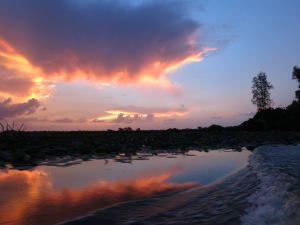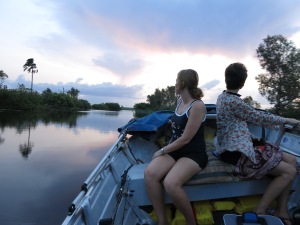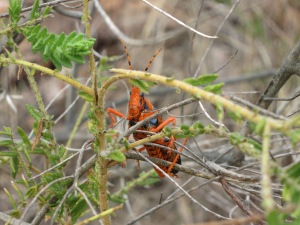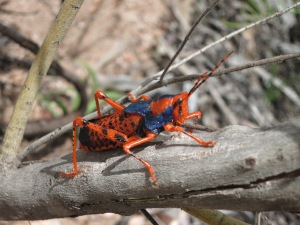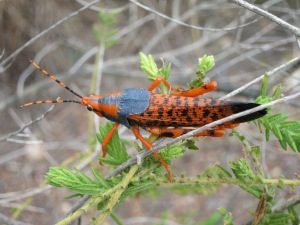*Namely cane toad busting, boat trailer parking and how to conduct insect-finding expeditions in 40-degree heat.
November 17, 1845.
‘Whilst on this expedition, we observed a great number of grasshoppers of a bright brick colour dotted with blue: the posterior part of the corselet and the wings were blue; it was two inches long, and its antennae three quarters of an inch.’ — Ludwig Leichhardt
January 24, 2013.
Mr Tea and I are on a slightly different expedition to that of Ludwig Leichhardt. Leichhardt took 14 months to travel from Moreton Bay to Port Essington. He had all the time in the world to carve his initial onto trees and spy unusual insects. We’ve got a long weekend. Still, there is a half-baked plan, cooked up with our friends Kristi and Bec, that we’ll look for Leichhardt’s famous and elusive grasshopper. We’re taking the tinny as well, for a spot of fishing and some sunset bird-watching, but to be honest, I’ll happily settle for my book and a banana lounge pool-side. Mr Tea wants to do all of the above, but most of all he wants to go to the Jabiru Bakery.
It’s the first stop on our adventuring itinerary.
“I just think they do a really good vanilla slice,” he says. “It’s the best bakery in all of Kakadu.”
It’s the only bakery in Kakadu, but Mr Tea has always been a glass half-full kind of guy.
With our great personal organisation skills, we walk in three minutes before closing. With palpable relish, Mr Tea surveys the spread of caramel slice, finger buns and pizza bread.
“Looks great,” he says. “Any recommendations?”
But she’s monosyllabic and no nonsense, the lady behind the counter. The other minion shrugs her shoulders, too; she’s busy salting one last order of chips before the shutters go down.
Mr Tea and I settle on a lamington and the much-anticipated piece of vanilla slice, which we pick at on the plastic outdoor furniture provided. The steady drip of sweat glues my bare legs to the chair and I have to peel each one off when I stand.
Now sated and covered in desiccated coconut, our expedition continues on to Cooinda. We check in and go to launch the tinny in Home Billabong. It’s all going well until I have to park the boat trailer. I accelerate a little too hard out of the water and lurch over a muddy pot hole into the car park. In the process, I manage to collide with a fellow fisho’s trailer, leaving a pretty severe indentation and taking out a tail light.
The fisherman is nowhere to be seen but his girlfriend is on the boat ramp and is angry enough for two people. She demands my licence, which of course is back in the hotel room, so she hustles Mr Tea’s instead and makes a point of taking a photo of it on her iPhone. Together, we lift the corner of our trailer off theirs. Stressed, I resort to my default emotional response of tears. I’m mortified, especially because I don’t know Bec and Kristi that well and I want them to like me.
I wish I‘d brought my sunglasses, so I could cry in camouflage.
Mr Tea is unperturbed and we get the boat onto the billabong, and follow the channel down to Yellow Water. The water level is only just high enough to lift the boat over the floodplains. Every so often, Mr Tea turns the engine off and grabs the filleting knife in order to free the prop from a stranglehold of weeds and water lillies.
I’m nervous every time, watching for crocs.
We finally make it out onto Yellow Water. My tears ease somewhat as we whip around the billabong. The light changes from mauve to spectacular orange, yellow and pink. The rain that hovers oh too far away whips the clouds into tornado spirals, and purple lightning flashes between them. I watch two crocodile heads submerge on approach. The magpie geese honk in formation above our heads while the whistling ducks form a shuffling mosh pit on the bank.
Nature is a show-off sometimes.
When we get back, it’s dark and the air is thick with the sound of burping cane toads. A few get squashed under the Prado wheels, but Kristi decides to take the fight further with a quick cane toad busting session before tea. She collects about a dozen cane toads in a plastic bag, which she takes back to her hotel room freezer. We meet up afterwards for a drink on her small porch. When I go to the fridge to get a second glass of wine, I can hear the toads moving around in the freezer. I slam the door shut.
The next morning, we have to sort out the unfortunate boat trailer situation before we can hunt for grasshoppers. But I am banned from the negotiation process.
“You’ll hand over your entire bank account and offer our first born,” Mr Tea says, rolling his eyes. “It’s only a dent and a tail light.”
He cuts a deal with our angry fisherwoman and her nonplussed boyfriend. We settle on $150 compensation and some repairs, which Mr Tea performs with a shifting wrench he happened to have handy. When the transaction is done, I’m glad to see the couple begin their drive back to Katherine.
Bec and Kristi also have to check out, so Kristi asks if she can leave her bag of toads in the freezer of our room.
“I don’t think they’re quite dead yet,” she says.
Mr Tea tells her to take them in Bec’s Esky. I direct her to the freezer.
Finally, our Leichhardt’s Grasshopper expedition gets underway. The four of us head out to Nourlangie rock. It’s lunchtime by the time we get to the car park. A couple of dishevelled backpackers are munching sandwiches in their 4WD, burning diesel for the aircon.
We walk 100 metres up an access track. The bush is burnt out. Regrowth sprouts from the trees, while the charred remains of shrubs abound. This is escarpment country, sparse but beautiful.
I’ve got my eyes akimbo; our grasshopper is notoriously hard to find. His namesake, Leichhardt, was the first European to record a sighting back in the 1800s. But after a few more glimpses, the colourful grasshopper disappeared for around 120 years. Scientific records show that sightings began again around 1973. Now Leichhardt’s Grasshopper is only found in the Northern Territory at Keep River, Nitmiluk and in Kakadu National Park.
I’ve never spotted any kind of wildlife first in my life, but suddenly a vision of orange and blue flies past my face.
It’s our grasshopper. Long antennae, blue beads for eyes. Resplendent in a costume of bright orange, blue and black splotches. It’s never even heard the word ‘camouflage’. Leichhardt’s Grasshopper is an insect world centrefold. It nestles on a bush of green that has sprung from the burnt out land, pityrodia jamessii. It smells like mint and tea tree oil. Then there’s another grasshopper. And another. One flies off when we get too close, but four more hang tight on the same shrub, munching through those aromatic leaves, leaving the stems in their wake. It’s obviously quite the cordon bleu meal.
People spend months looking for this grasshopper. Our gang of four has walked 100 metres. I’ve spent more time looking for my keys. Our sighting seems as accidental as my collision with the boat trailer.
Later that night, thunder starts to crackle as we sit down to eat interpretations of pizza and vegetable korma. And then the sky erupts, blue and purple lightning and rain that pours through. It pools under the fluorescent lights and picnic tables.
I remember reading that the Jawoyn and Gundjeibmi people of West Arnhem Land call Leichhardt’s grasshopper Alyurr. Alyurr are children of the lightning man, Namarrgon, a powerful ancestral being. I’ve seen Namarrgon painted in white ochre, in Aboriginal rock art. The lightning slices the sky again; perhaps he’s looking for his children.
In the morning, I put Kristi’s bag of now-frozen cane toads in the bin. On the way home, I put my feet up on the dashboard and turn up The Black Keys. I think about our weekend expedition in flash cards. Orange and blue insect centrefolds, sunset on the billabong, cane toads in the freezer. Purple lightning and my boat ramp altercation.
I’m still a bit ashamed of my tears. I’m not sure Leichhardt would have wanted me in his touring party, but I’m glad to have seen his grasshopper.
